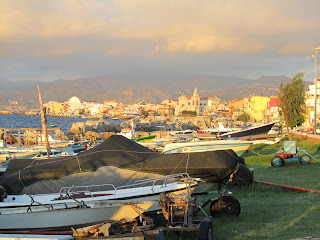Called the Castle of Euryalos in English, it was built between 402 and 397 B.C. and is the largest and most complete military structure from the Greek period. Apparently it took roughly 60,000 men to construct the fortress in six years. It is impressive with its well-preserved walls and tunnel system. If you're in the Siracusa area definitely check it out.
Siracusa, here we come!
Here again the notable meeting of the modern with the ancient is apparent as cars zip by Greek and Roman ruins.
The Greek theater of Siracusa.
The ear of Dionysius.
Apparently prisoners were kept within the cave and the cave's design allowed the guard standing outside to hear even the softest whispers uttered so there were no secrets.
Roman sarcophagi
Again, a cat sees history as a resting place.
Roman amphitheater
What remains of the church of San Giovanni, built between 700 and 800 A.D. and damaged by the earthquake in 1693, is famous for its catacombs.
San Giovanni's famous catacombs, second in size only to those of Rome, were reused ancient aqueducts.
Photos are not technically allowed so I had to take these in secret.
It seems that there are Greek or Roman ruins around every corner here in Siracusa.
The cathedral of Siracusa was built in the 7th century over the 5th century B.C. temple of Athens. The facade was rebuilt in Andrea Palma in 1725-53.
The columns from the original Greek temple can be seen incorporated into the walls of the existing church.
Local fisherman hope for a good catch.
So we leave Siracusa after having spent a marvelous day within its boarders.
*IMPORTANT NOTE!!!*
I have apparently reached my 1 GB limit for photos I can store on Blogspot so my choices are either pay a fee each year to have increased storage or start a new blog elsewhere. I now have a new blog hosted by travelblog.com which has unlimited photo uploads. It's simpler, but will offer you the same opportunity to see my photos and read my ramblings about my travel experiences.
Here is the link to the new blog:
http://www.travelblog.org/Bloggers/Rowan-Beraza/Click the button near the bottom that says "Latest Entry" to read my current post.
Here is a link to my first post using TravelBlog:
http://www.travelblog.org/Europe/Italy/Sicily/Augusta/blog-541422.html
*IMPORTANT NOTE!!!*
I have apparently reached my 1 GB limit for photos I can store on Blogspot so my choices are either pay a fee each year to have increased storage or start a new blog elsewhere. I now have a new blog hosted by travelblog.com which has unlimited photo uploads. It's simpler, but will offer you the same opportunity to see my photos and read my ramblings about my travel experiences.
Here is the link to the new blog:
http://www.travelblog.org/Bloggers/Rowan-Beraza/Click the button near the bottom that says "Latest Entry" to read my current post.
Here is a link to my first post using TravelBlog:
http://www.travelblog.org/Europe/Italy/Sicily/Augusta/blog-541422.html





































































